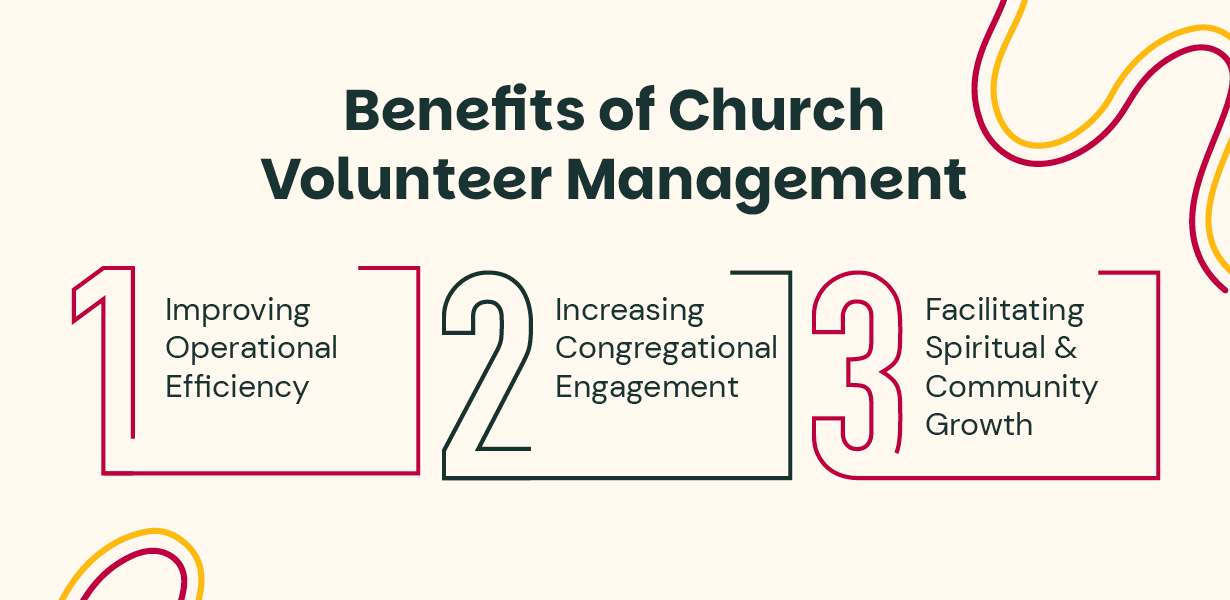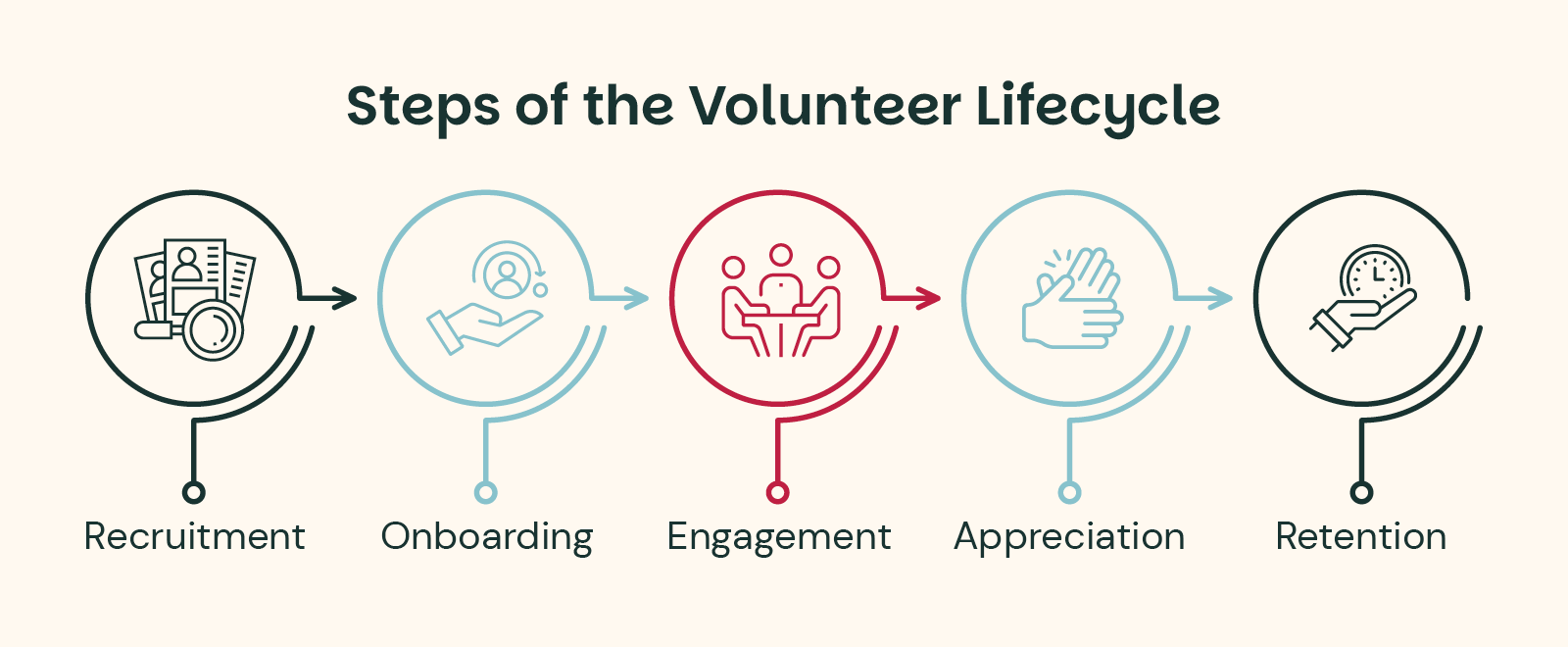Volunteer Retention: How to Foster Long-Term Loyalty
It’s no secret that volunteers provide immense value to your organization through their contributions of time and talent. In fact, the average...
8 min read
 Timothy Sarazen
Nov 6, 2025 1:58:38 PM
Timothy Sarazen
Nov 6, 2025 1:58:38 PM

Your church’s volunteers provide critical support for its ministry, which congregants are increasingly realizing as they seek ways to deepen their faith and community engagement. As of 2025, 24% of regular attendees volunteer weekly through their churches, up from 15% in 2024. And this figure doesn’t even include those who serve on a monthly, semimonthly, or as-needed basis!
These rising numbers mean that effective church volunteer management is more important now than ever. In this guide, you’ll learn all you need to know about this process, including:
As you develop a volunteer management strategy based on these topics, remember that your church’s mission should always be your top priority and the guiding principle of your efforts. Additionally, if you use the right tools to streamline the volunteer recruitment process, all you need to bring to the table is your mission. That being said, let’s get started!
Church volunteer management is the systematic and strategic process of recruiting, engaging, and coordinating volunteers within your church. Its goal is to create an environment where your volunteers can thrive as they contribute their time and talents to your ministry with minimal administrative hassle on your team’s end.
There is some overlap between management practices in other volunteer-supported organizations (such as charities, schools, and healthcare organizations) and the best approach for your church. However, church volunteer management can be a bit more complicated due to the wide variety of roles your congregation can take on. Depending on your church’s size and structure, they might:

Church volunteer management also falls under the umbrella of member engagement at many churches (because the priority is getting church members to volunteer), whereas volunteering is a broader supporter engagement method for most other organizations.
Despite the additional complexities that come with managing volunteers at your church, a strong approach to this process can have many positive impacts on your ministry, such as:

Naturally, your church can only maximize these benefits if you implement the right volunteer management strategies at every stage of your volunteers’ journey.
The volunteer journey or lifecycle is a tool to help you visualize how each of your church’s volunteers goes from not being engaged in this way to repeatedly and enthusiastically contributing their time to your ministry. Let’s discuss what each step entails and how you can effectively manage volunteers at that stage.

The recruitment stage of the volunteer lifecycle is all about making a positive impression on potential volunteers and encouraging them to sign up to meet one of your church’s needs. It lays the foundation for the rest of the volunteer experience, which is why many volunteer management experts believe that retention begins upon recruitment.
Here are some tips to help your church recruit the right volunteers for the right positions:
Keep in mind that recruitment for some roles may be more complex than others. Finding volunteers to fill the greeter position described above will likely just require reviewing their applications and reaching out to confirm individuals’ interest and understanding of the role. However, other roles may require additional vetting for skill-related or safety reasons, such as auditioning prospective musicians or conducting background checks for children’s ministry volunteers.
Onboarding ensures new volunteers have everything they need to perform well in their roles. In your initial training session, make sure to cover:
After this basic training, have new volunteers shadow more experienced volunteers during their first shifts. This one-on-one time allows new volunteers to see how they should tackle their responsibilities and ask any questions they may still have before they start taking on those duties independently.
Engagement encompasses everything you do to help volunteers become more involved and motivated as they serve at your church. Some key areas of church volunteer engagement to incorporate into your management strategy include:
When executed well, these engagement tips ensure your efforts benefit your volunteers, your team, and your church’s overall ministry.
Once volunteers have begun engaging, it’s important to express your gratitude. While being recognized shouldn’t be a volunteer’s primary motivation for serving in your church, it is an added bonus that can encourage them to keep working to the best of their ability.
You can show appreciation for your volunteers in a variety of ways, depending on what resonates with them. For instance, you might:
These formal recognition methods are most effective after a volunteer’s first shift, when they achieve a goal or reach a milestone of service, and at the end of each year. Don’t worry about sending a thank-you note every time someone volunteers—if they serve weekly or even monthly, the work will pile up for you, and it may overwhelm recipients. However, your team should make sure to verbally express their gratitude to each volunteer after their shifts so they always know their work is appreciated.
Although appreciation and retention are usually considered separate stages in the volunteer lifecycle, they overlap significantly. Recognizing volunteers for their work is the first step in getting them to stick around long-term.
From there, your church’s volunteer retention efforts may also involve:
Generally speaking, the higher your church’s volunteer retention rate is, the better equipped your program and overall ministry will be to thrive for years to come.
Especially as your church’s volunteer program grows, the right software can make essential tasks at every stage of the volunteer lifecycle easier for your team. If you’re ready to invest in a volunteer management solution or want to upgrade your existing tools, look for an all-in-one platform that will support the complete journey through features like:

For a user-friendly solution that includes all of these features and more, look no further than Better Impact! More than 25,000 organizations around the world of all sizes and missions (including houses of worship and other faith-based organizations) leverage our Volunteer Impact platform for strategic, streamlined management of all aspects of their volunteer programs. But don’t just take our word for it—check out our client case studies to see just how much Volunteer Impact has improved real organizations’ efforts!

Church volunteer management is a unique beast to tackle, but with a solid plan for navigating each stage of the volunteer lifecycle, you’ll create a program that supports your ministry in essential ways for the long haul. Use the tips in this guide to get started, and remember that investing in the right software (like our Volunteer Impact solution!) can be a make-or-break factor in your strategy’s effectiveness.
For more information on volunteer management, check out these resources:

Featured Posts

It’s no secret that volunteers provide immense value to your organization through their contributions of time and talent. In fact, the average...
.png)
Volunteers serve as the backbone of many successful nonprofits, contributing their time, expertise, and passion to further important missions....
.png)
Volunteers are the lifeblood of many nonprofit organizations. By dedicating their time, energy, and skills, these individuals help nonprofits fulfill...